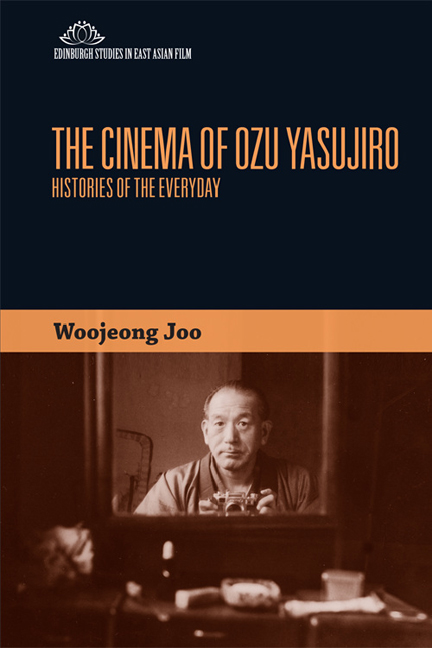Book contents
- Frontmatter
- Contents
- List of Figures
- List of Tables
- Acknowledgements
- Introduction: Ozu, History and the Everyday
- 1 Early Ozu: Shōshimin Film and Everyday Realism
- 2 Ozu in Transition: The Coming of Sound and Family Melodrama
- 3 Wartime Ozu: Between Bourgeois Drama and National Policy Film
- 4 Postwar Ozu: Ozu's Occupation-era Film and Tokyo Regained
- 5 Late Ozu: New Generation and New Salaryman Film
- Conclusion
- Notes
- Glossary of Japanese Terms
- Select Filmography
- Select Bibliography
- Index
Introduction: Ozu, History and the Everyday
Published online by Cambridge University Press: 07 December 2017
- Frontmatter
- Contents
- List of Figures
- List of Tables
- Acknowledgements
- Introduction: Ozu, History and the Everyday
- 1 Early Ozu: Shōshimin Film and Everyday Realism
- 2 Ozu in Transition: The Coming of Sound and Family Melodrama
- 3 Wartime Ozu: Between Bourgeois Drama and National Policy Film
- 4 Postwar Ozu: Ozu's Occupation-era Film and Tokyo Regained
- 5 Late Ozu: New Generation and New Salaryman Film
- Conclusion
- Notes
- Glossary of Japanese Terms
- Select Filmography
- Select Bibliography
- Index
Summary
Among Japanese filmmakers, Ozu Yasujiro (1903–63) has long occupied a particular status. Generally recognised as one of the three most representative masters of Japanese cinema – along with Kurosawa Akira and Mizoguchi Kenji – he is best known as ‘the most Japanese’ director who, ‘as a kind of spokesman’, represents ‘the Japanese flavour’ with his films. But no other term describing Ozu's cinema is as much misrepresented and misunderstood as this ‘Japaneseness’. Ozu was initially introduced to Western countries as something ‘foreign’ that required a special effort to be understood. Legend has it that the Japanese film industry was reluctant to export Ozu's films to the West for fear that they would not be understood by Western audiences. In retrospect, this is absolute nonsense, if not an inverse form of Orientalism. It might be true that the real intention of Japanese producers was to continue the initial success of such jidaigeki (period drama) films as Rashōmon/Rashomon (Kurosawa Akira, Daiei, 1950), Ugetsu monogatari/Ugetsu (Mizoguchi Kenji, Daiei, 1953), or Jigokumon/ Gate of Hell (Kinugasa Teinosuke, Daiei, 1953) in the West in the early 1950s.2 But even so, I think it is very unlikely that contemporary Western audiences would have struggled any harder to understand Ozu's urban family drama Tōkyō monogatari/Tokyo Story (1953) than Kurosawa or Mizoguchi's period films. In fact, Japanese film companies began to realise the limitations of jidaigeki, and attempted to introduce gendaigeki (contemporary drama) to the West. The first such event held in Los Angeles in 1956 showed the films of Gosho Heinosuke, Naruse Mikio, Toyoda Shirō as well as those of Ozu, whose ‘treatment of modern Japanese life’ was appreciated for being ‘truly international in its universal human appeal’.
The studies of Ozu that followed in the West also contributed to the mystifi - cation of the meaning of Japaneseness. Donald Richie argued that Ozu's cinema was Japanese because it actualised on screen ‘traditional virtues of [Japan]’, for example, the ‘quality of restraint’, which was expressed through a strictly low-height and static camera work that produces the famous ‘tatami shot’.
- Type
- Chapter
- Information
- The Cinema of Ozu YasujiroHistories of the Everyday, pp. 1 - 20Publisher: Edinburgh University PressPrint publication year: 2017



